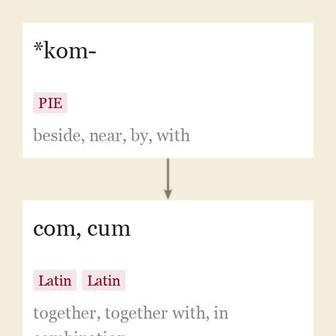recondite (adj.)
1640年代,“被移除或隐藏不见”,可能源自过时的法语 recondit,源自拉丁语 reconditus,是 recondere 的过去分词,“储藏,隐藏,隐瞒,重新放置,重新上架”,该词源于合并形式的 com- “在一起”(参见 com-)和 -dere “放”(来自 *dhe- 的 PIE 词根,“设定,放置,安放”)。
“从心智视野中隐藏,远离正常理解,深奥”的含义来自1650年代; 对于作家或作品,“鲜为人知,晦涩难懂”的含义则来自于1788年。相关词汇: Reconditeness。
recondite 的相关词汇

这是一个单词构成元素,通常表示“与,一起”,源自拉丁语 com,是古典拉丁语 cum 的古老形式,意为“一起,与,结合”,源自原始印欧语言 *kom- 的“旁边,附近,与”的意思(与古英语 ge- 、德语 ge- 类似)。在拉丁语中,该前缀有时被用作一种强调语气的方式。
在元音和清辅音前,缩写为 co-; 在 -g- 前,同化为 cog- 或 con-; 在 -l- 前,同化为 col-; 在 -r- 和 -v-, 前,同化为 cor- 和 con-; -c-, -d-, -j-, -n-, -q-, -s-, -t- 之前,也被同化为 con-。这种同化非常普遍,以至于经常被用作正常形式。
*dhē-,原始印欧词根,意为“设定,放置”。
它构成以下词汇的全部或部分: abdomen; abscond; affair; affect(第一动词)“在心中留下印象”; affect(第二动词)“假装”; affection; amplify; anathema; antithesis; apothecary; artifact; artifice; beatific; benefice; beneficence; beneficial; benefit; bibliothec; bodega; boutique; certify; chafe; chauffeur; comfit; condiment; confection; confetti; counterfeit; deed; deem; deface; defeasance; defeat; defect; deficient; difficulty; dignify; discomfit; do(动词); doom; -dom; duma; edifice; edify; efface; effect; efficacious; efficient; epithet; facade; face; facet; facial; -facient; facile; facilitate; facsimile; fact; faction(名词1)“政党”; -faction; factitious; factitive; factor; factory; factotum; faculty; fashion; feasible; feat; feature; feckless; fetish; -fic; fordo; forfeit; -fy; gratify; hacienda; hypothecate; hypothesis; incondite; indeed; infect; justify; malefactor; malfeasance; manufacture; metathesis; misfeasance; modify; mollify; multifarious; notify; nullify; office; officinal; omnifarious; orifice; parenthesis; perfect; petrify; pluperfect; pontifex; prefect; prima facie; proficient; profit; prosthesis; prothesis; purdah; putrefy; qualify; rarefy; recondite; rectify; refectory; sacrifice; salmagundi; samadhi; satisfy; sconce; suffice; sufficient; surface; surfeit; synthesis; tay; ticking(名词); theco-; thematic; theme; thesis; verify。
它是以下词汇的假定来源/其存在的证据为:梵语 dadhati “放置,安排”; 阿维斯塔语 dadaiti “他放置”; 古波斯语 ada “他制造”; 赫梯语 dai- “放置”; 希腊语 tithenai “放置,设置,安置”; 拉丁语 facere “做,干; 执行; 带来”; 立陶宛语 dėti “放置”; 波兰语 dziać się “正在发生”; 俄语 delat' “做”; 古高地德语 tuon,德语 tun,古英语 don “做”。